Sun 29 Mar 2020
A Movie Review by Dan Stumpf: THE LINEUP (1958).
Posted by Steve under Crime Films , Reviews[6] Comments
REVIEWED BY DAN STUMPF:
THE LINEUP. Columbia Pictures, 1958. Eli Wallach, Robert Keith, Richard Jaeckel, Mary LaRoche, William Leslie, Emile Meyer, Marshall Reed, Raymond Bailey, Vaughn Taylor, Cheryl Callaway, Robert Bailey, Warner Anderson. Screenplay: Stirling Silliphant. Director: Don Siegel.
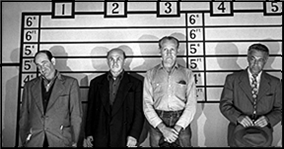
The Lineup is a film of contradictions, managing somehow to be both intriguing and dull, subversive and complacent – not at the same time, but close enough together to make one wonder how it ever got made at all. No one who has ever seen it forgets the killing at the skating rink or the wild car chase and shoot-out that climax he movie; on the other hand, one is hard-pressed to remember anything much happening in the whole first twenty minutes of the thing. Memorable and forgettable: that’s The Lineup.
The reasons for this strange duality are readily apparent now, but at the time it must have seemed .like a good idea, to the producers at Columbia to make a low-budget feature film based on a popular TV series. And Don Siegel probably looked — on the surface, at least — like the best man to direct it, having done the pilot for the television series four years earlier . He must have seemed like a natural.
But Don Siegel had changed a lot in the years since The Lineup was first televised; he had entered the most anarchic and most personals age of his career, using low-budget action films as vehicles to say something meaningful about individuals trying to attain identity in an Anonymous Society: films like Riot in Cell Block11, Baby Face Nelson, and Invasion of the Body Snatchers, his clearest and mos deliberately paranoid statement on the dangers of Unity. And it was this middle-aged rebel, not the fair-haired boy of four years earlier, who brought his feelings to bear on The Lineup, which mus have turned out to be a lot different from what the producers had in mind.
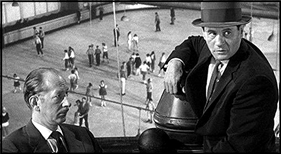
For one thing, he scenes built around the police/heroes of the piece, are thoroughly, almost painstakingly, dull. Siegel shoots he Police Procedure parts in an obviously disinterested style, routine set-up following routine set-up as the story meanders towards no place in particular with no noticeable sense of pace. The Police are sympathetic enough, to be sure, but they’re also boring and banal in this movie, which makes for a pretty soporific first twenty minutes or so … Until the killers come on.
With the introduction of Eli Wallach and Robert Keith, we get a look at last at he film Siegel wanted to make, and an impressive job it is, too. The flatness of the photography suddenly looks impressive, with the characters struggling in long shot against a landscape of towering ships and crowded streets, standing in sharp contrast against anonymous hotel rooms and deserted docks as they march resolutely towards some predestined end.
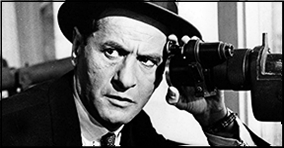
Wallach and Keith are quickly established as enforcers for some anonymous but highly structured criminal organization. They, and everyone they meet, have a small and well-defined part to play in some complex and mysteriously important scheme; the nondescript man who gives them their assignment, the nameless figure who pronounces their death sentences, and everyone else they encounter, all either conform to the rigid norm of their social order or die for departing from them.
It’s a daring message for a film supposedly designed to celebrate the glories of Police Routine, but Siegel states his theme clearly and repeatedly, from the siren-blast time signal that begins and ends his characters assignment, to the way Keith keeps correcting Wallach’s stammer, right down to the infringement of The Rules that dooms both men: Siegel demonstrates the peril of acing Human in a world of Pod People, and, intriguingly, he makes his point around a deliberately unsympathetic character.
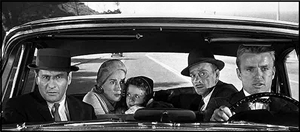
As the killer (ironically called Dancer) Eli Wallach’s ripe features and beady eyes seem constantly cocked and ready, about to explode into some socially unsanctioned violence as he moves skittishly about the San Francisco landscape. He plays this perfectly against Keith, as his mysterious supervisor, who comes on like a voice-over announcer in a commercial, constantly reminding his subordinate about how well they are doing their job as he methodically jots down the last words of their victims in a little notebook.
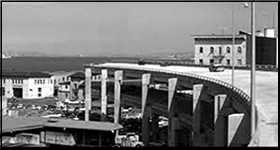
The last half of The Lineup is heady stuff indeed, with well-staged bursts of violence built around a rapidly accelerating plot, culminating in one of the most chilling performances ever committed to film, by a perfect unknown named Vaughan Taylor, and a car-chase across a half-completed freeway system — done mostly with back-projection — that completely outclasses the more expensive and highly-touted car-chase scenes that became a staple of the Movies in the 1970s.
So catch this movie the next time it comes along. Have a good book to read or something to occupy your mind for the first twenty minutes, then sit back o enjoy one of the most surprisingly perverse movies ever.

March 29th, 2020 at 10:00 pm
Wallach has the showier part, but the last time I watched it I found myself wondering if he might have been too much without the balancing “sanity” of Keith’s character — who in his own way is as unbalanced as Wallach.
Together they make for a more interesting menace than either on their own, with the strange tension between them part of the suspense.
March 29th, 2020 at 10:15 pm
That’s an excellent observation. At least it feels right. It’s been a while since I’ve seen this, and I do have to tell you, while I remember Wallach’s performance vividly, I don’t remember Keith at all.
March 30th, 2020 at 11:10 pm
I just caught this movie. I found the police procedural part fine, only one small lapse. The first criminal collection was perfect, the second didn’t work for me, and the third was good. Then it took off. I enjoyed it, though your other recent review, The Tiger Woman, is my favourite B movie at the moment.
March 31st, 2020 at 10:46 am
The scene between Wallach & Vaughan Taylor in the Sutro Baths Museum pegs out the creepy meter for me. The juxtaposition between the innocent school children enjoying the (even then) hokey attractions and the dope deal gone bad (if I remember the circumstances correctly) is a fine Grand Guignol twist. I made a “pilgrimage” to the site of the Sutro Baths a few years back, knowing that the attractions were long gone, but I let my imagination make the most of the remaining concrete foundation ruins and was able to do so nicely, thanks to THE LINEUP.
March 31st, 2020 at 4:02 pm
A great “pilgrimage” story, Bill. Thanks!
March 31st, 2020 at 7:35 pm
[…] Speaking of Perversity, I wanted to say a word or two about a French film called The Burglars, directed by Henri Verneuil and, based on David Goodis’s melancholy novel The Burglar. Never — not once in many many years of watching Trashy Movies — have I seen a film so utterly unfaithful o its source material. […]